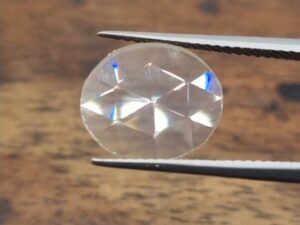This article will provide you with valuable insights into the Old Mine Cut diamond. We’ll explore its history, characteristics, and how it differs from other diamond cuts. We’ll also guide you on how to identify, value, and care for Old Mine Cut diamonds, as well as their place in modern jewelry.
Table of Contents
The History of the Old Mine Cut
Origin and Naming
The Old Mine Cut has a storied history that can be traced back to the late 17th century. The name “Old Mine” is a tribute to the diamond mines in India and Brazil, which were the primary sources of diamonds during that era. When newer mines opened in Africa, these original sources became known as “old mines,” giving this particular cut its name.
Popularity and Era
The Old Mine Cut was especially popular during the Georgian (1714-1837) and Victorian (1837-1901) eras. It was the preferred diamond cut for many iconic pieces of jewelry created during these periods. While its popularity declined with the introduction of modern cutting techniques, it has experienced a resurgence among collectors and those who appreciate vintage jewelry.
Evolution and Influence
The Old Mine Cut holds the distinction of being one of the earliest “brilliant cuts,” designed to maximize a diamond’s sparkle. Over time, it has evolved and influenced the development of new diamond cuts, including the modern Round Brilliant Cut. However, the Old Mine Cut retains its unique charm and character, serving as the foundational basis upon which modern diamond cuts are designed.
Characteristics of the Old Mine Cut
The Old Mine Cut is distinguished by its unique set of characteristics that set it apart from modern diamond cuts. Below are some of the key features that define this historic cut:
Facet Structure
The Old Mine typically has 58 facets, similar to a modern Round Brilliant Cut, but the arrangement and size of these facets are different. The facets are usually larger and less uniform, contributing to a distinct, softer sparkle that many describe as “romantic” or “candle-like.”
Shape and Proportions
The Old Mine Cut is generally cushion-shaped, resembling a square with rounded corners. The cut often has a high crown, a small table, and a deep pavilion, which all contribute to its unique brilliance. The proportions of the Old Mine diamond are not standardized, as they were crafted by hand to maximize the natural beauty of each individual diamond. For more on how these characteristics relate to the 4 C’s, you can read my post on The 4 C’s and Antique Diamonds.

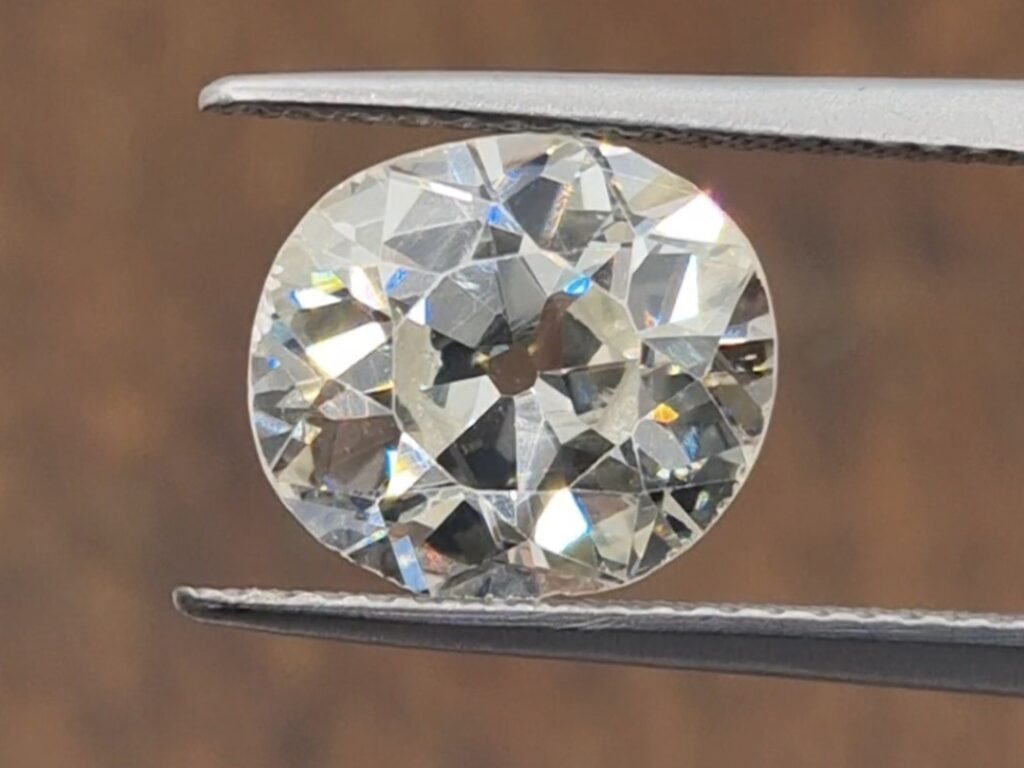
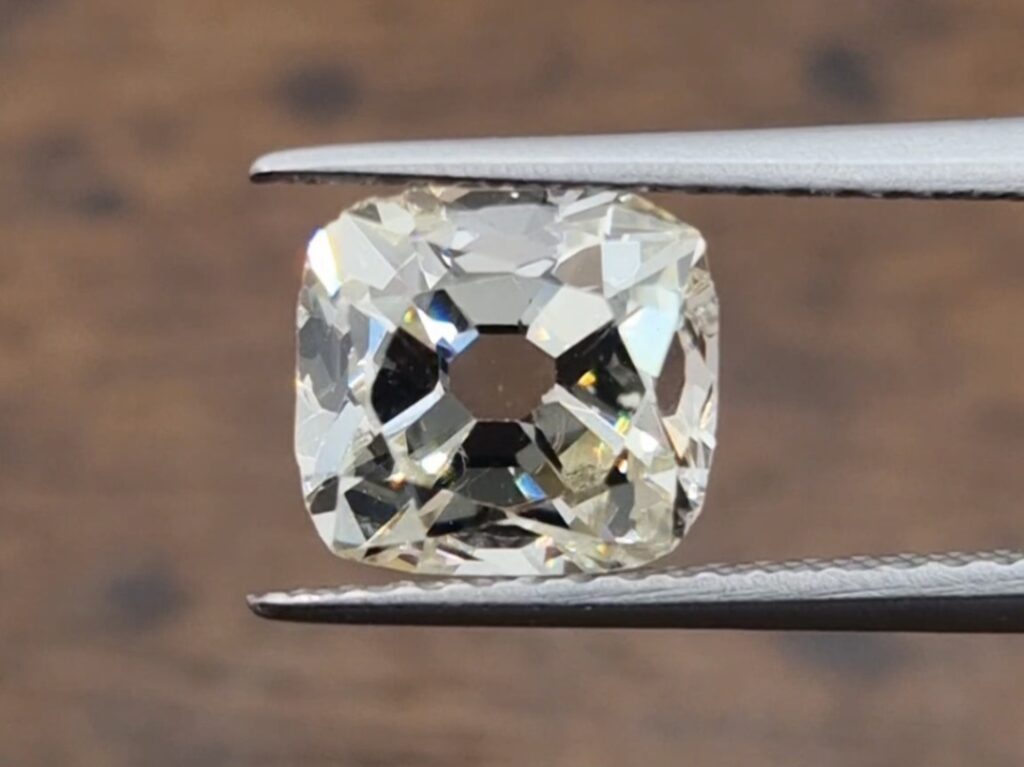
Comparison with Other Cuts
While the Old Mine Cut shares some similarities with other antique cuts like the Old European Cut, it has its own unique characteristics. Unlike the Old European Cut, which is more circular, the Old Mine has a more squared shape. Additionally, the Old Mine Cut’s facet structure and arrangement are distinct, giving it a unique light performance.
How to Identify an Old Mine Cut Diamond
Identifying an Old Mine diamond requires a keen eye and some knowledge of its distinguishing features. Here’s how you can go about it:
Key Features
- Cushion-Shaped Outline: Unlike modern Round Brilliant Cuts, Old Mine diamonds often have a cushion-like shape, which is essentially a square with rounded corners.
- High Crown and Small Table: These diamonds usually feature a high crown and a smaller table, which are indicative of older cutting techniques.
- 58 Facets: While the number of facets is similar to a modern Round Brilliant, the facets themselves are often larger and less precisely cut.
- Open Culet: Old Mine Cuts typically have an “open” culet, which means it is flat rather than coming to a point. This feature is a hallmark of antique diamonds.
- Deep Pavilion: The bottom part of the diamond, known as the pavilion, is usually deeper in Old Mine Cuts, contributing to their unique brilliance.
Identification Tools and Methods
- Magnification: Using a jeweler’s loupe or microscope can help you closely examine the diamond’s facets and other features, such as antiquity, for identification.
- Certification: If available, check the diamond’s certification. Reputable labs like GIA or HRD will often specify the cut of the diamond although they don’t certify it is antique.
- Expert Consultation: When in doubt, consult with a certified gemologist or a reputable jeweler who specializes in antique diamonds.
- Comparison: Placing the diamond next to a modern cut can also help highlight the unique characteristics of an Old Mine Cut.
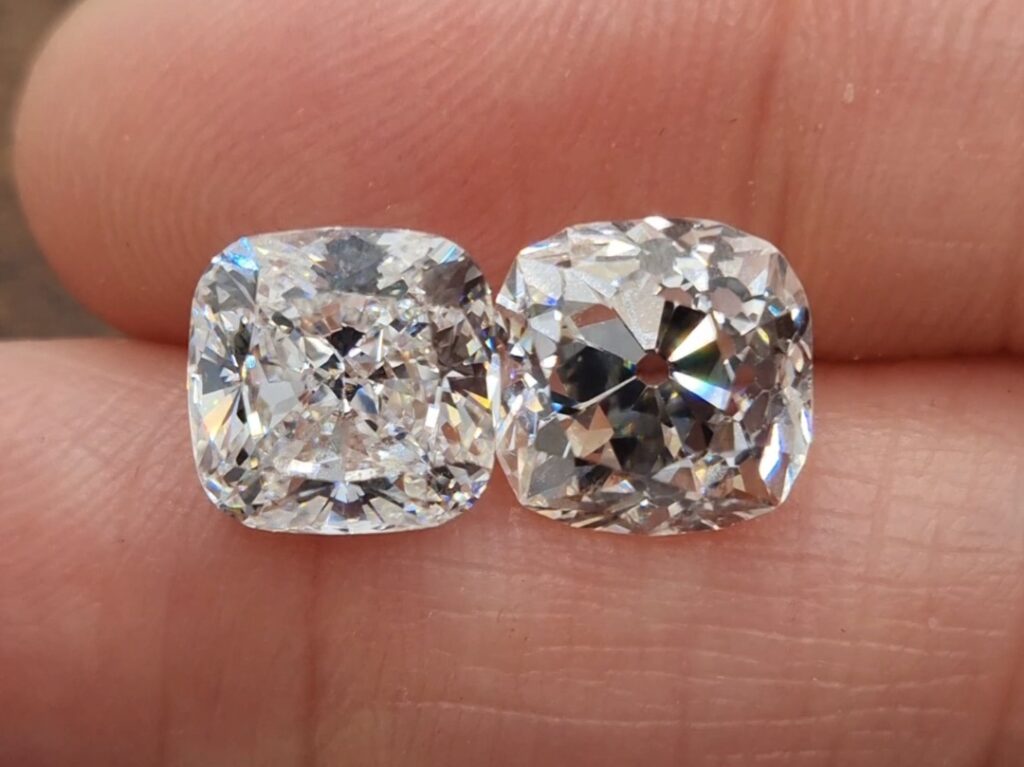
For a more comprehensive understanding of how Old Mine Cuts fit into the broader landscape of diamond cuts, you may find it helpful to read my post on the 4 C’s and Antique Diamonds.
The Value of an Old Mine Cut Diamond
The value of an Old Mine diamond is influenced by a variety of factors, much like any other diamond. However, there are some unique considerations to keep in mind.
Contributing Factors
- Rarity: Old Mine diamonds are less common than modern cuts, which can make them more valuable. Naturally the market for these diamonds is not as big so not all antique stones are more valuable than modern cuts.
- Historical Significance: The age and historical context of these diamonds can also add to their value.
- Unique Characteristics: The distinct facet structure and overall appearance can make these diamonds highly sought after by collectors and enthusiasts.
- Condition: Given their age, the condition of the diamond can significantly impact its value. Microscopic chips, cracks, and other imperfections can often be a good sign that the stone is genuinely antique. However, if these imperfections are too large or problematic, they can lower the diamond’s value.
- Certification: A certificate from a reputable lab confirming the diamond’s characteristics can also influence its value.
Is it an Antique Old Mine Cut?
It’s important to note that not all diamonds labeled as “Old Mine Cut” are actually antiques. While a gemological report may state that a diamond is an “Old Mine Cut,” this only refers to the shape and facet structure, not the age of the stone. To determine if an Old Mine diamond is genuinely antique, close examination with a jeweler’s loupe is often necessary. Alternatively, consulting an expert in antique diamonds can provide more definitive answers.
Price Comparison
Old Mine diamonds can sometimes command higher prices than their modern counterparts, especially if they are in excellent condition and possess desirable characteristics. However, the market for these diamonds is more niche, which can also affect their price.
Old Mine Cut vs. Old European Cut
When it comes to antique diamonds, the Old Mine Cut and the Old European Cut are often mentioned in the same breath. Both cuts have a rich history and unique characteristics that make them highly sought after. However, there are key differences and similarities between the two that are worth exploring.

Differences and Similarities
Differences
- Shape: The Old Mine Cut typically has a somewhat cushioned, square shape. The Old European Cut, on the other hand, is more rounded, resembling a modern Round Brilliant Cut although they are rarely perfect circles.
- Culet: Old Mine Cuts often have a larger, more noticeable culet compared to the Old European Cut, which usually has a smaller, less visible one.
- Table Size: The table in an Old Mine Cut is generally smaller than that of an Old European Cut, which contributes to the unique way each cut interacts with light.
- Symmetry: Old Mine Cuts are less symmetrical due to their hand-cut nature, while Old European Cuts, which are also handmade, are generally more symmetrical, reflecting advancements in cutting technology.
Similarities
- Historical Context: Both cuts were popular during overlapping time periods, with the Old Mine Cut being prevalent during the Georgian and early Victorian eras, and the Old European Cut gaining popularity in the late Victorian era.
- Brilliance: Both cuts are designed to maximize brilliance, although the way they achieve this differs due to their unique facet structures.
- Hand-Crafted: Both types of diamonds were primarily hand-cut, making each stone unique.
- Desirability: Both cuts are highly sought after today for their vintage appeal and unique characteristics.
Preferences and Use Cases
The choice between an Old Mine Cut and an Old European Cut often comes down to personal preference. Some may prefer the squarer shape and larger culet of the Old Mine diamond, while others may be drawn to the more rounded appearance and smaller culet of the Old European Cut. Both cuts are frequently used in various types of jewelry, from engagement rings to vintage pieces
Where to Buy Old Mine Cut Diamonds
Purchasing an Old Mine Cut diamond is an exciting venture, but it’s crucial to know where to look for these rare and unique gems. The market for Old Mine Cut diamonds is specialized, and finding the right stone requires a bit of research and expertise. The key is to find a trustable expert in antique stones, whether online or offline.
Online vs. Offline
- Online Retailers: Websites specializing in antique and vintage jewelry often have a selection of Old Mine Cut diamonds. Online platforms offer the convenience of shopping from home and usually provide detailed information and certifications for each diamond.
- Brick-and-Mortar Stores: Physical stores specializing in antique jewelry can provide a hands-on experience. You can examine the diamond under different lighting conditions and consult with experts on-site. However, the selection may be limited, and prices can be higher due to overhead costs.
Reputable Sellers
- Certification: Always look for diamonds that come with a certificate from reputable gemological laboratories. This ensures that you’re getting a real natural diamond.
- Expert Consultation: If you’re unsure about the authenticity of an Old Mine diamond, it’s advisable to consult with an expert in antique diamonds.
- Customer Reviews: Whether shopping online or offline, customer reviews and testimonials can provide valuable insights into the quality of the diamonds and the reliability of the seller.
The Old Mine Cut in Modern Jewelry
The Old Mine diamond, with its rich history and unique characteristics, has found a resurgence in popularity among those who appreciate vintage charm. But its appeal isn’t limited to antique pieces; modern designers are increasingly incorporating Old Mine Cut diamonds into contemporary settings. Here’s how this classic cut is making a statement in today’s jewelry world.
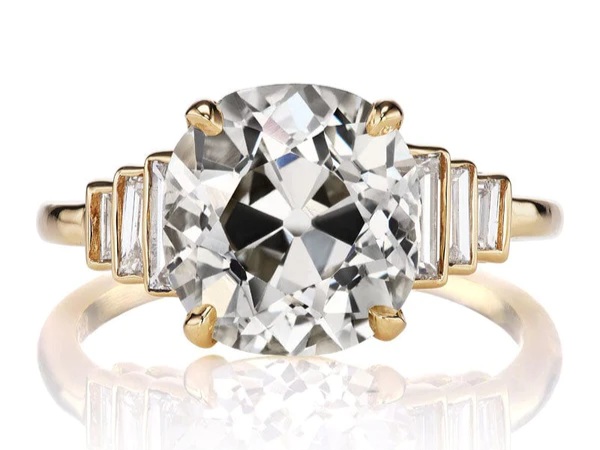
Contemporary Designers
Many of today’s leading jewelry designers are drawn to the Old Mine Cut for its unique facet structure and romantic glow. They often use these diamonds as centerpieces in engagement rings, pendants, and other fine jewelry, blending old-world elegance with modern design elements.
Modern Settings
- Solitaire Settings: The Old Mine Cut diamond stands out beautifully when set as a solitaire, allowing its unique characteristics to shine.
- Halo Settings: Surrounding an Old Mine Cut diamond with a halo of smaller, modern-cut diamonds creates a stunning contrast and adds extra sparkle.
- Bezel Settings: For a sleek, modern look, designers are using bezel settings that encase the Old Mine Cut diamond in a thin frame of metal.
- Vintage-Inspired Designs: Many modern pieces feature Old Mine Cut diamonds in settings that draw inspiration from different historical eras, offering the best of both worlds.
Conclusion
The Old Mine Cut diamond is a fascinating gem that bridges the gap between the past and the present. Its unique characteristics, historical significance, and enduring appeal make it a sought-after choice for both antique collectors and modern jewelry enthusiasts. Whether you’re interested in its intricate facet structure, its role as the precursor to modern brilliant cuts, or its resurgence in contemporary designs, the Old Mine Cut diamond offers something for everyone.
Understanding how to identify and value these diamonds can enhance your appreciation for these timeless gems. Moreover, knowing where to buy them and how they compare to other antique cuts like the Old European Cut can help you make informed decisions.
In a world where mass-produced, machine-cut diamonds are the norm, the handcrafted allure of the Old Mine diamond stands as a testament to the artistry and craftsmanship of the past. It’s a cut that captures the imagination, offering a tangible link to a bygone era while fitting seamlessly into modern designs.
Additional Resources
- Gemological Institute of America (GIA): For comprehensive courses and articles on diamonds, including antique cuts.
- HRD Antwerp: A leading authority in diamond certification, offering valuable insights into the grading and evaluation of antique diamonds.
- “Diamonds: An Early History of the King of Gems” by Jack Ogden: This book provides an in-depth look into the history of diamonds, including antique cuts.
- “The Nature of Diamonds” by George E. Harlow: Covers the geological aspects of diamonds and offers a historical perspective.
- Online Courses on Gemology: Websites like GIA offer courses that delve into the intricacies of diamonds, including the Old Mine Cut.



